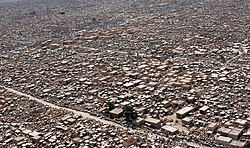Top Qs
Timeline
Chat
Perspective
Wadi-us-Salaam
Islamic cemetery in Najaf, Iraq From Wikipedia, the free encyclopedia
Remove ads
Wadi-us-Salaam[a] is an Islamic cemetery, located in the holy city of Najaf, Iraq. It is the largest cemetery in the world.[1][2] The cemetery covers 1,485.5 acres (601.16 ha; 6.01 km2; 2.32 sq mi) and contains more than 6 million bodies.[3] It also attracts millions of pilgrims annually.[4]
The cemetery is located near the shrine of Ali ibn Abi Talib, the fourth Sunni Caliph, as well as the first Shia Imam.[5] Thus, many Shi'ites in Iraq request that they be buried in this cemetery.[5] As a result of improved transportation methods, Shi'ites from across the globe are (or seek to be) buried in the cemetery. Modern burials are interred inside shared crypts.[6]
Remove ads
Shi'ite traditions about the cemetery
Summarize
Perspective

Shi'ites traditions hold that Abraham bought land in Wadi-us-Salaam, and that Ali had said the Wadi Al-Salaam was a part of heaven.[7] Shia also widely believe that Ali has the power to intercede for the deceased—lessening their suffering—during the passage of their soul from the worldly life[8] and if they are buried there, they will be raised from the dead on judgment day with their spiritual leader.[9] Additionally, it is believed that prophets Hud and Salih are buried here, according to some narrations.
Shi'ites are encouraged to bury their dead at the location through religious edicts[6] and the cemetery's expansion is also seen as being a result of Shi'isms "more permissive attitude than Sunnism with regard to the commemoration of the dead and the erection of mausoleums."[10]
Shi'ite funerary rituals
Religious rituals practiced at Wadi-us-Salaam before burial include:
- Washing the body and wrapping it at the cemetery.
- Conducting funeral prayers at the adjacent shrine of Ali.
- Carrying the freshly wrapped corpse around the shrine, in an act similar to that of Tawaf, before it is transported to the cemetery.
- Reciting some Qur'anic verses at the cemetery for the deceased.[11]
Remove ads
History
Daily burials have been on going for over 1,400 years and the site is on the Tentative List of UNESCO's World Heritage sites.[12] Burials in Najaf have been documented as early as the Parthian and Sassanid eras and ancient Mesopotamian cities often had similar cemeteries, where there was an accumulation of tombs.[13]
The cemetery saw heavy fighting during the 2004 Battle of Najaf. It is estimated that during the Iraq War, about 200 to 250 corpses were buried there daily; however, in 2010 this number had decreased to less than 100.[5] Approximately 50,000 new bodies are interred in the cemetery annually from across the globe.[14] This figure is an increase on the approximately 20,000 bodies, primarily from Iran, that used to be interred annually in the early 20th century.[15] Most Iraqi and many Iranian Shi'ites have a relative buried in the cemetery.[16]
As of 2014—coinciding with conflict against ISIL—it has been reported that burial plots are running out, resulting in many being stolen, illegally resold or improvised.[17] According to one gravedigger: "I've never had it so busy. Not even after 2003 or 2006 [the height of Iraq's civil war]."[18]
Remove ads
Important monuments
Tombs of the Grand Ayatollahs
The Grand Ayatollah, Muhammad Baqir al-Sadr, is buried in this cemetery. His successor, Muhammad-Sadiq al-Sadr is also buried there, and his grave is one of the most visited tombs in the cemetery.[19]
Shrine of Prophet Hud and Salih

First built in the 18th century under request of Moḥammad Mahdī Baḥr al-ʿUlūm over the purported tombs of Hud and Salih based on Shi'ite narrations. It was restored in the years 1918 to 1919 after the British desecrated it in 1917.[20] A full new reconstruction was started in 2018.
Site of Imam al-Mahdi
Site dedicated to Imam al-Mahdi.
Site of Imam Ja'far al-Sadiq
Site dedicated to Imam Ja'far al-Sadiq.
Prominent burials
- Rais Ali Delvari
- Khalou Hossein Bord Khuni Dashti
- Sayed Ali Qadhi Tabatabaei
- Abdul Hosein Amini
- Leyla Qasim
- Mirza Yahya Khoyi
- Amina al-Sadr
- Grand Ayatollah Muhammad Sadiq al-Sadr
- Grand Ayatollah Muhammad Baqir al-Sadr
- Hussain Qoli Khan Feyli, Vāli/Wāli of Posht-e-Kuh (modern day Ilam, Iran), and father of the last Vāli of Posht-e-Kuh Gholam Reza Khan.[21]
- Other religious figures
Notes and references
External links
Wikiwand - on
Seamless Wikipedia browsing. On steroids.
Remove ads



